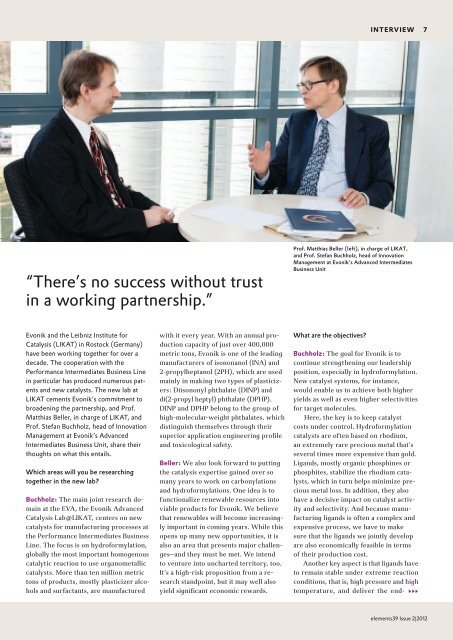Download - Evonik Industries
Download - Evonik Industries
Download - Evonik Industries
You also want an ePaper? Increase the reach of your titles
YUMPU automatically turns print PDFs into web optimized ePapers that Google loves.
“There’s no success without trust<br />
in a working partnership.”<br />
<strong>Evonik</strong> and the Leibniz Institute for<br />
Catalysis (LIKAT) in Rostock (Germany)<br />
have been working together for over a<br />
decade. The cooperation with the<br />
Performance Intermediates Business Line<br />
in particular has produced numerous patents<br />
and new catalysts. The new lab at<br />
LIKAT cements <strong>Evonik</strong>’s commitment to<br />
broadening the partnership, and Prof.<br />
Matthias Beller, in charge of LIKAT, and<br />
Prof. Stefan Buchholz, head of Innovation<br />
Management at <strong>Evonik</strong>’s Advanced<br />
Intermediates Business Unit, share their<br />
thoughts on what this entails.<br />
which areas will you be researching<br />
together in the new lab?<br />
Buchholz: The main joint research do -<br />
main at the EVA, the <strong>Evonik</strong> Advanced<br />
Catalysis Lab@LIKAT, centers on new<br />
catalysts for manufacturing processes at<br />
the Performance Intermediates Business<br />
Line. The focus is on hydroformylation,<br />
globally the most important homogenous<br />
catalytic reaction to use organometallic<br />
catalysts. More than ten million metric<br />
tons of products, mostly plasticizer alco-<br />
with it every year. With an annual production<br />
capacity of just over 400,000<br />
metric tons, <strong>Evonik</strong> is one of the leading<br />
manufacturers of isononanol (INA) and<br />
2-propylheptanol (2PH), which are used<br />
mainly in making two types of plasticizers:<br />
Diisononyl phthalate (DINP) and<br />
di(2-propyl heptyl) phtha late (DPHP).<br />
DINP and DPHP belong to the group of<br />
high-molecular-weight phthalates, which<br />
distinguish themselves through their<br />
superior application engineering profile<br />
and toxicological safety.<br />
Beller: We also look forward to putting<br />
the catalysis expertise gained over so<br />
many years to work on carbonylations<br />
and hydroformylations. One idea is to<br />
functionalize renewable resources into<br />
viable products for <strong>Evonik</strong>. We believe<br />
that renewables will become increasingly<br />
important in coming years. While this<br />
opens up many new opportunities, it is<br />
also an area that presents major challenges—and<br />
they must be met. We intend<br />
to venture into uncharted territory, too.<br />
It’s a high-risk proposition from a re -<br />
search standpoint, but it may well also<br />
InteRVIeW<br />
Prof. Matthias Beller (left), in charge of LIKAt,<br />
and Prof. Stefan Buchholz, head of Innovation<br />
Management at evonik’s Advanced Intermediates<br />
Business Unit<br />
what are the objectives?<br />
Buchholz: The goal for <strong>Evonik</strong> is to<br />
continue strengthening our leadership<br />
position, especially in hydroformylation.<br />
New catalyst systems, for instance,<br />
would enable us to achieve both higher<br />
yields as well as even higher selectivities<br />
for target molecules.<br />
Here, the key is to keep catalyst<br />
costs under control. Hydroformylation<br />
catalysts are often based on rhodium,<br />
an extremely rare precious metal that’s<br />
several times more expensive than gold.<br />
Ligands, mostly organic phosphines or<br />
phosphites, stabilize the rhodium catalysts,<br />
which in turn helps minimize precious<br />
metal loss. In addition, they also<br />
have a decisive impact on catalyst activity<br />
and selectivity. And because manufacturing<br />
ligands is often a complex and<br />
expensive process, we have to make<br />
sure that the ligands we jointly develop<br />
are also economically feasible in terms<br />
of their production cost.<br />
Another key aspect is that ligands have<br />
to remain stable under extreme reaction<br />
conditions, that is, high pressure and high<br />
hols and surfactants, are manufactured yield significant economic rewards. temperature, and deliver the end-<br />
333<br />
7<br />
elements39 Issue 2|2012
















